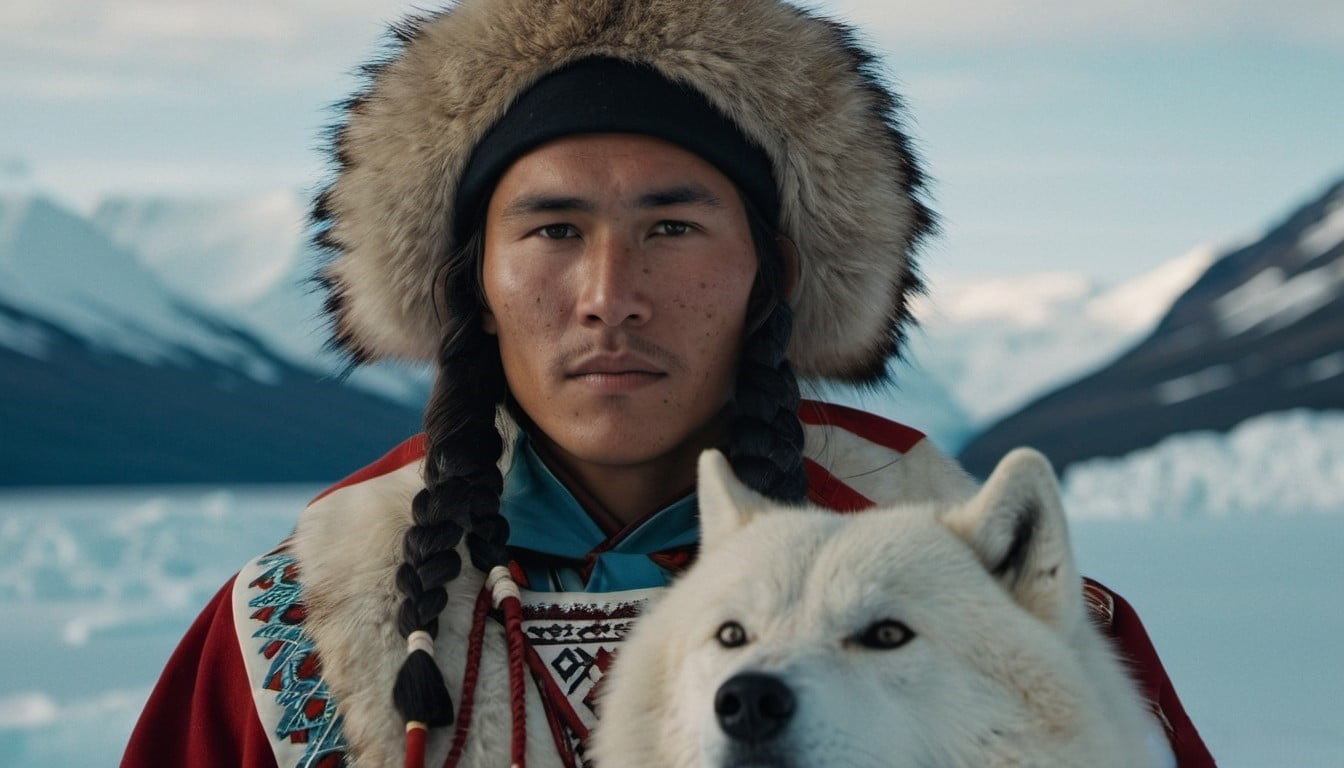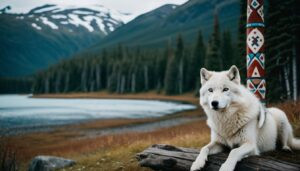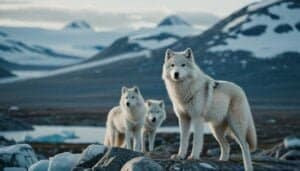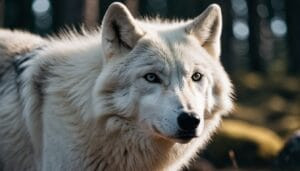Introduction
Arctic wolves hold a vital place in indigenous Arctic cultures, encompassing mythology, spiritual significance, practical uses, and ecological roles. These majestic creatures are deeply woven into the fabric of indigenous traditions, influencing hunting practices, ceremonial activities, and artistic expressions
Additionally, Arctic wolves play a crucial role in the Arctic ecosystem, impacting the natural balance and coexisting with indigenous peoples. This article will explore the multifaceted relationship between Arctic wolves and indigenous Arctic cultures, highlighting the significance of these animals in various aspects of life and the ongoing efforts to conserve both the wolves and the cultural heritage they support
Mythology, Spiritual Significance, and Traditions of Arctic Wolves
Arctic wolves, revered and respected in many indigenous Arctic cultures, are central to various myths, spiritual beliefs, and traditional practices. These animals are often seen as symbols of strength, resilience, and interconnectedness with nature
Arctic Wolves in Indigenous Myths
Arctic wolves feature prominently in the mythology of several indigenous Arctic cultures. These myths often depict the wolves as powerful and mystical beings, embodying qualities that are highly valued within the community
For instance, the Inuit people have numerous legends involving Arctic wolves. One such legend tells of Amarok, a giant wolf that hunts alone and is often invoked as a protective spirit against evil forces
Amarok is not just a fearsome predator but also a guardian, illustrating the complex relationship between humans and wolves in Inuit culture. The wolf’s solitary nature in these stories often symbolizes the idea of independence and the strength found in solitude
Another example can be found among the Chukchi people of Siberia, who believe that wolves have the ability to guide souls to the afterlife. In these traditions, wolves are seen as spiritual guides, bridging the gap between the physical and spiritual worlds
This belief underscores the deep spiritual connection indigenous peoples have with Arctic wolves, viewing them as more than mere animals but as essential components of their spiritual and cultural identity
Spiritual Symbolism of Arctic Wolves
The spiritual symbolism of Arctic wolves extends beyond mythology, playing a crucial role in the day-to-day spiritual practices of indigenous Arctic peoples. Wolves are often seen as totems or spirit animals, embodying specific traits that individuals or clans aspire to emulate
In many Arctic cultures, wolves symbolize endurance, loyalty, and cooperation—qualities essential for survival in the harsh Arctic environment. The pack mentality of wolves, characterized by strong social bonds and teamwork, is particularly admired and serves as a model for human behavior
This symbolism is evident in the way indigenous communities organize themselves, often valuing collective effort and mutual support
Moreover, the howling of wolves is sometimes interpreted as a form of communication with the spirit world. Indigenous shamans may incorporate wolf howls into their rituals, believing that these sounds can help to connect with ancestral spirits and seek guidance
This practice highlights the profound respect and reverence that indigenous Arctic cultures have for the natural world and its inhabitants
Arctic Wolves in Indigenous Art and Stories
Art and storytelling are powerful mediums through which the cultural significance of Arctic wolves is conveyed. Indigenous Arctic peoples use various forms of art, including carvings, masks, and paintings, to depict wolves and their place in the world
Wolves are frequently represented in intricate carvings and totem poles, serving as visual reminders of their spiritual and cultural importance. These artistic expressions often depict wolves in dynamic poses, emphasizing their strength and agility
Through these depictions, artists convey not only the physical attributes of wolves but also their symbolic meanings, such as bravery and leadership
Stories featuring wolves are passed down through generations, preserving the cultural heritage and teachings of indigenous peoples. These stories often carry moral lessons, such as the importance of community, respect for nature, and the balance between independence and interdependence
By sharing these tales, indigenous Arctic cultures ensure that the wisdom and values associated with wolves are kept alive for future generations
Ceremonial Roles of Arctic Wolves
Arctic wolves also hold significant roles in various ceremonial practices among indigenous Arctic cultures. These ceremonies often honor the wolves and acknowledge their contribution to the community’s spiritual and physical well-being
During hunting ceremonies, wolves may be invoked to bless the hunters with their skills and endurance. The presence of wolf imagery or symbols in these ceremonies is believed to bring good fortune and success in hunting endeavors. This practice reflects the deep gratitude and respect indigenous peoples have for wolves, recognizing their role in sustaining their way of life
In other ceremonial contexts, such as rites of passage or healing rituals, wolves are seen as protectors and guides. Shamans may don wolf skins or use wolf-themed artifacts to channel the spirit of the wolf and harness its power for healing or protection
These ceremonial uses of wolf imagery and symbolism underscore the integral role that Arctic wolves play in the spiritual and cultural fabric of indigenous Arctic societies
Practical and Environmental Roles of Arctic Wolves
Arctic wolves are integral to the daily lives and environmental understanding of indigenous Arctic cultures. Their presence influences hunting practices, provides resources, and plays a critical role in the Arctic ecosystem
Hunting and Tracking
Arctic wolves are esteemed by indigenous Arctic peoples for their exceptional hunting skills, which serve as a model for human hunters. Observing wolf behavior, particularly their pack strategies and endurance, offers valuable lessons for effective hunting in the harsh Arctic environment
Indigenous hunters often study wolf tracks and movements to locate prey. Wolves are skilled at identifying and pursuing game, and their trails can lead hunters to herds of caribou, muskoxen, or other animals. By understanding wolf behavior, hunters can predict the movement patterns of their prey, increasing their chances of a successful hunt
Furthermore, wolves are seen as allies in maintaining healthy populations of game animals
By preying on weak or sick individuals, wolves help to ensure that only the strongest and healthiest animals survive, contributing to the overall health of the ecosystem. This natural selection process benefits both wolves and human hunters by sustaining robust populations of game animals
Clothing and Tools
Arctic wolves provide valuable resources for indigenous Arctic peoples, particularly in the realm of clothing and tool-making. The harsh Arctic climate necessitates the use of durable and warm materials, and wolf pelts are highly prized for their insulating properties
Wolf fur is exceptionally warm and resilient, making it ideal for clothing items such as parkas, mittens, and boots. These garments are essential for survival in extreme cold, protecting against frostbite and hypothermia. The use of wolf pelts in clothing not only provides practical benefits but also carries cultural significance, as wearing wolf fur can symbolize strength and connection to the natural world
In addition to clothing, wolf bones and teeth are used to create tools and decorative items. Bones can be fashioned into needles, awls, and other implements necessary for daily life, while teeth are often incorporated into jewelry or ceremonial objects
These practices demonstrate the resourcefulness and ingenuity of indigenous Arctic peoples in utilizing every part of the animal, reflecting a deep respect for the wolves they hunt
Arctic Wolves in the Arctic Ecosystem
Arctic wolves play a crucial role in the Arctic ecosystem, maintaining the balance between predator and prey and ensuring the health of the environment. Their presence affects the population dynamics of various species and influences the structure of the ecosystem
As apex predators, Arctic wolves regulate the populations of herbivores such as caribou and muskoxen. By controlling these populations, wolves help to prevent overgrazing and the degradation of vegetation, which is vital for the overall health of the ecosystem. This balance is essential for the survival of many species, including those that indigenous Arctic peoples rely on for food and other resources
Moreover, the presence of wolves can indirectly benefit other species. For example, by keeping herbivore populations in check, wolves ensure that plant communities remain diverse and robust, providing habitat and food for smaller animals and birds
This intricate web of interactions highlights the interconnectedness of the Arctic ecosystem and the importance of wolves in maintaining its stability
Coexistence with Indigenous Arctic Peoples
The relationship between Arctic wolves and indigenous Arctic peoples is one of mutual respect and coexistence. Indigenous communities have developed a profound understanding of wolf behavior and ecology, which informs their interactions with these animals
Traditionally, indigenous Arctic peoples have viewed wolves as kin and respected them as fellow inhabitants of the land. This perspective fosters a harmonious coexistence, where wolves are not seen as mere predators or competitors but as integral components of the natural world. This respect is evident in the way indigenous hunters approach wolf territories and the care they take to avoid unnecessary conflicts
Additionally, indigenous knowledge about wolves contributes to contemporary conservation efforts. Indigenous Arctic peoples possess a wealth of traditional ecological knowledge, which includes insights into wolf behavior, habitat requirements, and population dynamics
This knowledge is invaluable for scientists and conservationists working to protect Arctic wolves and their habitat
Conservation initiatives often involve collaboration with indigenous communities, recognizing their expertise and the importance of integrating traditional knowledge with scientific research
These efforts aim to ensure the long-term survival of Arctic wolves while supporting the cultural heritage and livelihoods of indigenous Arctic peoples
Conservation of Arctic Wolves and Indigenous Cultures
The conservation of Arctic wolves is intrinsically linked to the preservation of indigenous Arctic cultures
Efforts to protect these animals and their habitats are critical not only for ecological reasons but also for maintaining the cultural heritage and traditional lifestyles of indigenous Arctic peoples
Conservation Efforts and Challenges
Conserving Arctic wolves involves addressing numerous challenges, from climate change to human-wildlife conflicts. These efforts are often complex and require a multifaceted approach that includes scientific research, policy-making, and community engagement
Climate change poses one of the most significant threats to Arctic wolves and their habitat. Rising temperatures lead to the melting of sea ice and changes in vegetation, which affect the availability of prey and the overall ecosystem balance
Conservationists are working to mitigate these impacts through various means, such as advocating for reduced greenhouse gas emissions and implementing adaptive management strategies to help wildlife cope with changing conditions
Human activities, such as industrial development and resource extraction, also threaten Arctic wolves. Oil and gas exploration, mining, and road construction can fragment habitats and disrupt migration patterns, making it difficult for wolves to find food and mates. Conservation efforts aim to minimize these impacts by promoting sustainable development practices and creating protected areas where wolves can thrive without human interference
Additionally, conservationists must address issues related to human-wolf conflicts, particularly in regions where wolves come into contact with livestock or compete with hunters for game
Initiatives such as compensation programs for livestock losses and community-based wildlife management plans are essential for reducing conflicts and fostering coexistence between humans and wolves
Supporting Indigenous Arctic Cultures
The survival of Arctic wolves is deeply intertwined with the preservation of indigenous Arctic cultures. These cultures have coexisted with wolves for centuries, and their traditional knowledge and practices are vital for effective conservation
Indigenous Arctic peoples possess a profound understanding of their environment, including the behavior and ecology of Arctic wolves. This traditional ecological knowledge (TEK) is invaluable for informing conservation strategies and ensuring that they are culturally appropriate and effective
Collaborative projects that integrate TEK with scientific research are increasingly recognized as best practices in conservation
Supporting indigenous Arctic cultures involves more than just environmental protection; it also means upholding the rights and sovereignty of indigenous peoples. This includes recognizing their land rights, respecting their cultural practices, and involving them in decision-making processes related to conservation. By empowering indigenous communities, conservation efforts can be more sustainable and inclusive
Programs that promote the cultural and economic well-being of indigenous Arctic peoples are also crucial
These may include initiatives that support traditional livelihoods, such as sustainable hunting and fishing, as well as efforts to preserve indigenous languages, arts, and ceremonies. By strengthening the resilience and vitality of indigenous cultures, these programs help ensure that the relationship between Arctic wolves and indigenous peoples continues to thrive
Integrated Conservation Approaches
Effective conservation of Arctic wolves and support for indigenous cultures require integrated approaches that consider both ecological and cultural factors. This holistic perspective ensures that conservation efforts address the needs of wildlife and the communities that depend on them
One successful model is the establishment of co-managed protected areas, where indigenous peoples and government agencies work together to manage and conserve natural resources. These areas not only safeguard critical habitats for Arctic wolves but also provide a framework for incorporating indigenous knowledge and practices into conservation planning
Another key approach is community-based conservation, which empowers local communities to take an active role in protecting their environment
By involving indigenous Arctic peoples in monitoring wildlife populations, managing resources, and implementing conservation measures, these programs build local capacity and foster a sense of ownership and responsibility
Education and outreach are also vital components of integrated conservation efforts. Raising awareness about the importance of Arctic wolves and the cultural heritage of indigenous peoples helps garner support for conservation initiatives
This can be achieved through various means, such as educational programs, public campaigns, and partnerships with schools and organizations
Finally, ongoing research is essential for understanding the complex dynamics between Arctic wolves, their environment, and indigenous cultures. Studies that explore the impacts of climate change, habitat fragmentation, and human-wildlife interactions provide critical insights for developing effective conservation strategies
Collaborative research that includes indigenous perspectives and knowledge ensures that conservation efforts are well-informed and culturally sensitive
Conclusion
Arctic wolves hold a significant place in the cultures of indigenous Arctic peoples, reflected in their myths, spiritual beliefs, and daily practices. These majestic animals are not only essential for the ecological balance of the Arctic but also for the cultural heritage and traditions of indigenous communities
Conservation efforts aimed at protecting Arctic wolves are intrinsically linked to supporting and preserving indigenous Arctic cultures
Through integrated approaches that combine traditional ecological knowledge with modern scientific research, and by promoting sustainable development and community-based conservation, it is possible to ensure the continued coexistence and mutual respect between Arctic wolves and the indigenous peoples who have shared the Arctic landscape with them for centuries
Protecting these vital connections is crucial for the future of both Arctic wolves and the rich cultural legacy they help sustain











